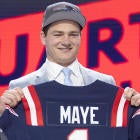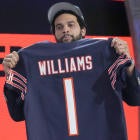Quarterback stability is highly coveted in the NFL because it's a vital ingredient for sustained success. Some of the NFL's most significant transactions occur in an effort to get the position settled.
The 49ers made an unexpected move at the Oct. 31 trading deadline by acquiring Jimmy Garoppolo, whose rookie contract expires after the season, from the Patriots for a 2018 second-round pick. Garoppolo has yet to make his 49ers debut because he has been focused on learning the offense. There isn't a set timetable for Garoppolo to play. Garoppolo is a prime candidate for a franchise tag, which is expected to be in the neighborhood of $23 million to $24 million, if a new deal isn't in place by early March.
Demand is usually much greater than the supply of desirable quarterbacks typically available in the offseason, but 2018 might be one of the rare instances where this isn't the case.
Here's a look at the passers who could be on the quarterback carousel in the offseason:
Brees recently reiterated his desire to finish his career in New Orleans although he is going to play out his contract, a one-year extension for $24.25 million signed early last season. The Saints no longer have to rely on Brees' passing for success because of one of the NFL's most potent rushing attacks and a perpetually weak pass defense that has been fixed. Brees is on pace to throw for under 4,500 yards for the first time since 2009. The 38-year-old demonstrated that he is still capable of winning games with his arm in an improbable Week 11 come-from-behind overtime victory against the Redskins.
Brees' contract was structured with 2018 through 2020 contract years that automatically void on March 14, the last day of the 2017 league year. This voiding date eliminates the possibility of Brees being given a franchise tag since it is after the designation period ends March 6. If an extension isn't worked out between the end of the season and the voiding date, the Saints will have an $18 million salary cap charge in 2018 regardless of where Brees plays next year because of the proration from the $30 million signing bonus he received with his 2016 extension.
It might make sense for Brees and the Saints to go year-to-year since Father Time is undefeated. The 2018 money could be converted into a real contract where the voiding of the 2019 and '20 contract years is delayed until the last day of the 2018 league year in March 2019.
There isn't anything in Brees' history to suggest that he would give the Saints a hometown discount. His current contract made him the NFL's second highest-paid player by average yearly salary when signed. Regaining that place in the league's salary hierarchy would likely mean a one-year deal for 2018 in the neighborhood of $26.5 million.
Expected to contend for the NFC East title, the Giants appear to be destined for a top-five pick in the 2018 NFL Draft. Wholesale changes (front office, coaching, personnel) might be on the horizon. Manning spending his entire career with the Giants could be in jeopardy because of the disappointing season. Landing a high pick would put the Giants in position to find Manning's successor. The Giants can't deal Manning to another team without his permission since he has a no-trade clause in his contract, which runs through the 2019 season. The Jaguars have been most frequently mentioned as a potential destination for Manning because his former head coach Tom Coughlin is Jacksonville's executive vice president of football operations.
Designated as a franchise player for a second straight year, Cousins is playing the 2017 season for a fully guaranteed $23,943,600 because he rejected a Redskins offer reportedly worth $133 million over six years. This offer contained $72 million in overall guarantees, of which $53 million was fully guaranteed at signing. Under franchise tag rules, the Redskins are prohibited from signing Cousins to a multiyear contract until the end of the 2017 regular season on Dec. 31.
Redskins president Bruce Allen has indicated that designating Cousins as a franchise player in 2018 for a third and final time at almost $34.5 million is a possibility despite the steep cost. Receiving another franchise tag will make continuing to go year-to-year before hitting free agency in 2019 extremely attractive unless the Redskins are willing to make him the NFL's highest-paid player over Lions quarterback Matthew Stafford, who signed a five-year, $135 million contract extension with an NFL-record $92 million of overall guarantees during the preseason. Another option is using a transition tag for $28,732,320, which would only give the Redskins a right to match another team's offer sheet.
Cousins could be a litmus for quarterback salaries should he become an unrestricted free agent because quality passers in their prime almost never hit the open market. He is performing like he did during the 2015 and '16 seasons, when he was one of the NFL's most productive quarterbacks, despite a higher degree of difficulty this time around. The Redskins' offensive line has been decimated by injuries. Cousins' rapport with the wide receivers isn't nearly as good with DeSean Jackson and Pierre Garcon signing with the Buccaneers and 49ers in free agency. Additionally, he has had to adjust to a new play-caller with Sean McVay becoming a Coach of the Year candidate for his quick turnaround of the Rams. Nonetheless, Cousins is on track for his third straight season with at least 4,000 passing yards, 25 touchdown passes, a top-10 completion percentage and a touchdown-to-interception ratio greater than 2-1.
It's conceivable that Cousins could command $30 million per year with $100 million in guarantees on the open market because there are more NFL teams than competent quarterbacks. Some of the quarterback-needy teams, such as the Browns and Jets, will have an abundance of cap space next offseason.
The Chiefs trading up to use the 10th overall pick in this year's draft on Patrick Mahomes put Smith on notice. A 5-0 start with Smith looking like an MVP candidate ended speculation that this season would be his last in Kansas City. The Chiefs dropping to 6-4 not only renewed talk that Smith's days in Kansas City are numbered but has some clamoring for Mahomes to take over at quarterback now. Missing the playoffs entirely or another early exit will likely result in the transition from Smith to Mahomes next season. Financially, it makes sense for the Chiefs to move on from Smith's four-year, $68 million extension, which expires after the 2018 season, in the offseason. The Chiefs have the NFL's fourth-most 2018 salary cap commitments at slightly over $179.5 million with a little more than $3.5 million of cap space that can be carried over to next year. Trading or releasing Smith would net the Chiefs $17 million in cap room in 2018.
Bradford was probably going to be in an enviable position with good health. A contract similar to Derek Carr's ($25 million per year with $70 million in overall guarantees) as a free agent would have been a possibility provided he could have maintained or improved upon his 2016 performance. In 2016, Bradford set an NFL single-season record with a 71.6 completion percentage and threw for a career-high 3,877 yards while getting comfortable with Minnesota's offense on the fly after a surprising trade from the Eagles in the days leading up to the season-opener.
Bradford got off to a great start this season. He earned NFC Offensive Player of the Week honors after completing 84.4 percent of passes for 346 yards and three touchdowns in a Week 1 victory over the Saints. He only played one more half of football before landing on injured reserve because of issues with his left knee. Two ACL tears in this knee kept Bradford out of action for 25 games over the 2013 and '14 seasons. He recently underwent a minor arthroscopic procedure on the knee, which didn't reveal any structural damage.
Renewed concerns about durability make Bradford a risky proposition for a lucrative long-term deal. Even with a clean bill of health by the time free agency starts in March, teams might be reluctant to commit more to him than his current two-year, $35 million contract (worth up to $40.5 million through salary escalators and incentives) containing $26 million in guarantees.
Poor outings early in the preseason following a 2016 in which Bortles regressed badly prompted Jaguars head coach Doug Marrone to put the quarterback job up for grabs. Bortles retained his job after responding positively to the competition. The Jaguars are leading the AFC South with a 7-3 record thanks to the NFL's best defense (first in total defense and points allowed) and strongest ground game (first in rushing yards). Bortles has been effective operating primarily as a game manager. Barring a late-season collapse, the Jaguars will make the playoffs for the first time in a decade. The 2014 third overall pick is scheduled to make $19.053 million in 2018 since the Jaguars picked up their option for a fifth year. The Jaguars could still part ways with Bortles before his 2018 salary becomes fully guaranteed on the first day of the 2018 league year, which is March 14, especially if he proves to be a liability in the playoffs.
Head coach Sean McDermott benching Taylor last week while the Bills are in contention for a wild-card playoff berth signals he doesn't fit into the team's long-range plans. Starting 2017 fifth-round pick Nathan Peterman in Week 11 against the Chargers was an unmitigated disaster. He was replaced by Taylor after throwing five interceptions in the first half. Nonetheless, McDermott was initially noncommittal about his Week 12 starter before deciding on Taylor.
Taylor reworked his contract in early March before Buffalo needed to a make a decision about picking up the option on his contract. He's currently under a two-year deal worth $30.5 million. According to CBS Sports NFL Insider Jason LaCanfora, several NFL executives think there will be a decent market for Taylor in the offseason because of his age, athleticism, upside and affordability. The 28-year-old's $16 million 2018 salary consists of a $6 million roster bonus payable on March 16, the third day of the 2018 league year, and a $10 million base salary. Buffalo would be left with a $7.64 million cap charge in 2018 from the signing bonus proration relating to Taylor's 2016 and '17 contracts, which would clear $9.14 million of cap space, by trading him before his roster bonus is due.
The 2017 season was going to be a pivotal one for Tannehill's future in Miami because he hasn't consistently lived up to being the eighth overall pick in the 2012 draft. Then he re-injured his left knee in the preseason. Tannehill originally hurt his knee late last season. He is out for the year after surgery to repair the ACL in the knee. Fortunately for Tannehill, Jay Cutler has struggled since being signed to fill in. A second straight playoff berth for the Dolphins seems remote. The lack of a better alternative in 2018 for head coach Adam Gase could be Tannehill's saving grace. It's conceivable that the Dolphins could look to deal Tannehill in the offseason but the injury could limit suitors and diminish his trade value. Tannehill's $17.475 million 2018 base salary includes $5.525 million already guaranteed for injury and becomes fully guaranteed on March 18, the fifth day of the 2018 league year. With a $19.8 million cap hit next year, the Dolphins would pick up $15.2 million of cap space by finding Tannehill a new home.
It wasn't feasible for the Vikings to pick up the $12.198 million fifth-year option in 2018 with Bridgewater because of the uncertainty of his recovery from the gruesome knee injury he suffered near the end of the 2016 preseason. Bridgewater is currently backing up Case Keenum after recently returning from his career-threatening ordeal. He could be entering the open market in 2018 no more than limited game action over the past two seasons unless Keenum begins to falter. The Vikings won the NFC North two years ago with Bridgewater in his second season.
Keenum has been a godsend for the Vikings. He has greatly exceeded the modest expectations the Vikings had for him when he was given a one-year, $2 million contract with $250,000 in incentives to back up Sam Bradford. Keenum has helped put Minnesota in control of the NFC North with Bradford's left knee ailing and Bridgewater just returning from his devastating knee injury. Seven of Minnesota's eight victories have come with Keenum under center. He is making it very difficult for head coach Mike Zimmer to switch quarterbacks despite Bridgewater's availability.
Keenum has probably done enough to be considered a stop-gap starter, particularly for a team that selects a quarterback early in the 2018 draft, or be given a chance to compete to start. These deals have been topping out at $7 million to $7.5 million per year with incentives and salary escalators that could make a two- or three-year deal as much $12 million per year recently. Winning in the playoffs could convince a team to give Keenum the type of money Mike Glennon, who had less of a track record, received from the Bears last offseason ($45 million over three years).
Botched paperwork prevented McCarron from going to the Browns at the Oct. 31 trading deadline. McCarron filled in capably for an injured Andy Dalton down the stretch of the 2015 season. In seven games (three starts), he connected on 79 of 119 passes (66.4 completion percentage) for 854 yards with six touchdowns and two interceptions, which was good for a 97.1 passer rating. McCarron would have a playoff win to his name but for ill-timed defensive penalties late in a wild-card loss to the Steelers. He has only taken five offensive snaps since then.
McCarron's status needs to be resolved before free agency starts March 14. He is scheduled to become a restricted free agent in 2018 because he wasn't given a year of service toward free agency in 2014 when he spent most of his rookie season on the non-football injury list with a shoulder injury. The 2014 fifth-round pick's representatives have filed a grievance asserting that he should have been placed on injured reserve instead because he passed his post-draft physical. A successful challenge will make McCarron an unrestricted free agent in March. With a ruling in favor of the Bengals, McCarron will likely be given the highest restricted free-agent tender, which will be a minimum of $4.106 million and a maximum of $4.301 million. The Bengals would get a first-round pick if they didn't match another team's offer sheet for McCarron under these circumstances.
Comparisons to Brock Osweiler, who was the biggest free-agent bust in 2016, were immediately made because Glennon's three-year, $45 million contract was sizeable for such an unproven commodity. Glennon has validated the comparisons through his poor play. He lost his starting job four games into the season to Mitchell Trubisky, who the Bears moved up one spot in this year's draft to select with the second overall pick. Glennon is making $16 million this year for his services, which surely won't be retained by the Bears in 2018. His contract also has a fully guaranteed $2.5 million roster bonus payable next March 16, the third day of the league year. Since the 2018 guarantee has an offset, the Bears could recoup the entire $2.5 million by releasing Glennon before the bonus is due and he makes at least that amount next year from another team. It's hard to imagine Glennon finding a situation where he could be an opening day starter in 2018 once the Bears let him go.











































